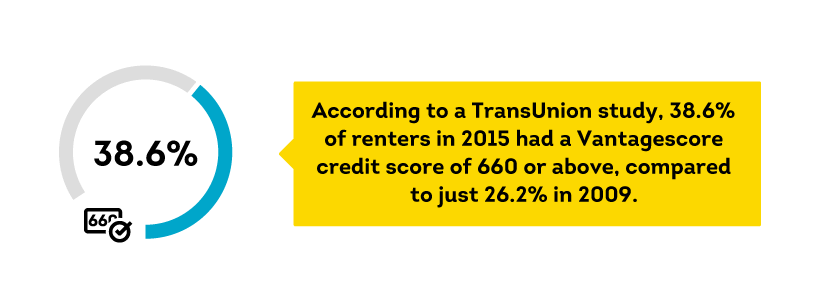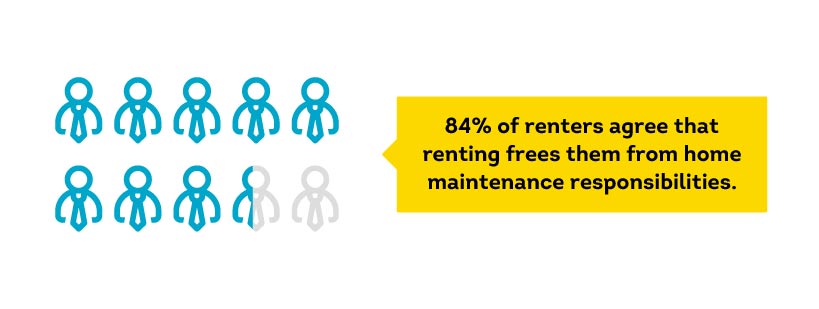Disclosure:
Remember that this material is intended to provide you with helpful information and is not to be relied upon to make decisions, nor is this material intended to be or construed as legal advice. You are encouraged to consult your legal counsel for advice on your specific business operations and responsibilities under applicable law. Trademarks used in this material are the property of their respective owners and no affiliation or endorsement is implied.
Renters today face the challenges of rising rent prices, but this doesn’t equate to rising homeownership rates. While some renters who would like to purchase a home cannot afford to, the good news is that many of today’s renters are managing their finances and credit obligations well. A new TransUnion study shows that, as we move into 2017, renters are lower risk and more credit active than they were after the last recession.
This means that in today’s rental market, landlords may find it easier to qualify tenants and worry less about on-time payments. With a complete tenant screening process and strong understanding of the tenant characteristics, rental property preferences, and behavior of today’s renter, landlords are well positioned to find great tenants.
Read on to discover the four ways that today’s renters have changed in the past several years:

1. They Have Better Credit
According to the TransUnion study, 38.6% of renters in 2015 had a VantageScore® credit score of 660 or above. Additionally, 69% of today’s renters think that they are good at managing their money and self-report their credit score as an average of 656, according to SmartMove’s guide on renter characteristics.
What does this mean for landlords? Since potential tenants have better credit scores than they did several years ago, landlords can be choosier when it comes to deciding who to rent to. This also means that landlords may have an easier time finding someone with a good track record of paying on-time, and who is in a good financial situation.
2. They Can Afford Higher Rent Prices
Despite mounting rent prices and larger percentages of tenant income going directly to paying them, 50% of today’s renters are able to keep their rent cost right in line with their budget. They can also afford higher rents now than they could in 2009. Even after a move, they are able to take on more auto loans and credit cards than their predecessors.
Higher incomes and increased money management skills are likely the catalyst behind this change. According to a TransUnion study on today’s renter characteristics, the average income for renters is $45,000. Plus, households making more than $50,000 annually have been the fastest growing segment of the rental market in the past three years.
An analysis of rental affordability by TransUnion, using its CreditVision® aggregate excess payment (AEP) algorithm, showed that a high percentage of renters still have money available after their monthly debt obligations are paid. In fact, more than half of renters have an AEP greater than $100, which means they can take on new payments and save money for emergencies. This is a promising signs for landlords, who will likely face less qualms about rental affordability and non-payment of rent.
What does this mean for landlords? You very likely can charge higher rent now or in the future. In fact, Rent.com’s 2015 Property Manager Report called out that 88% of property managers that they surveyed increased rental rates over the past year.

3. They are Older
As homeownership becomes less prevalent, landlords are seeing an older tenant demographic than they have in the past. Why? The renter age is increasing as the baby boomer generation downsizes. In fact, according to the Joint Center for Housing Studies of Harvard University (JCHS), the number of renters between ages 50 and 60 has increased by 4.3 million in the past decade.
This may be welcome news for landlords as studies show that older renters are more likely to be financially stable, have money set aside for emergencies, and earn a higher income.
Meanwhile, millennials are choosing to rent past the age when their parents began investing in homes. Zillow reports that younger Americans are staying in the rental market through their 20s and mid-30s. Many are delaying life decisions that may precede buying a home, such as marriage or starting a family.
They are also more likely than previous generations to be shouldering large student loans, meaning that it takes longer to save for a down payment on a house. In fact, statistics from TransUnion’s 2013 Understanding Today’s Renters Report shows that 40
40% of people rent because the cost of a down payment makes it too difficult to buy their own home.
What does this mean for landlords? All of this adds up to a larger tenant market for landlords and the ability to be highly selective about who they rent to.

4. They Often Rent By Choice
Even when affordability isn’t an issue, many renters choose to rent for the freedom and flexibility that renting offers. According to a recent Harris Poll, 84% of renters agree that renting frees them from home maintenance responsibilities. They also feel that renting gives them more flexibility to change where they live and protects them from declining home prices.
Many individuals believe that renting is cheaper, easier, and safer than buying, according to SmartMove’s report on the current state of the rental market. So it’s no surprise that while 13.8% of renters can afford to buy a typical home in their market, they would rather rent.
What does this mean for landlords? This bodes well for landlords who want to reduce the frequency of the costly and complicated tenant turnover process. For independent landlords, there’s even more good news. 51% of tenants prefer an independent landlord to a property management company.
Conclusion
While today’s renters are more financially stable than in previous years, it’s still important for landlords to maintain a consistent and thorough screening process. Not every renter falls into the above categories of high income and good credit. It’s in your best interest to view credit, criminal, and eviction reports on each and every potential tenant. The easiest way to do this is with SmartMove’s online tenant screening service.
TransUnion SmartMove is the landlord’s solution for great reports, great convenience, and great tenants. Landlords receive a credit report formatted exclusively for rental screening, a criminal report drawing from millions of criminal records, an eviction report, a ResidentScore, and a leasing recommendation. Renters get the peace of mind that only TransUnion, and not their landlord, will have access to their sensitive personal information.
Know your applicant.
Additional Disclosure:
Remember that this material is intended to provide you with helpful information and is not to be relied upon to make decisions, nor is this material intended to be or construed as legal advice. You are encouraged to consult your legal counsel for advice on your specific business operations and responsibilities under applicable law. Trademarks used in this material are the property of their respective owners and no affiliation or endorsement is implied.



